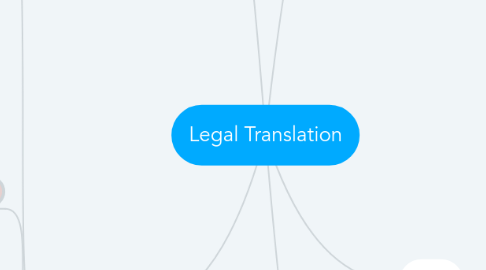
1. Typology
1.1. Differences and similarities among the different types of translation, like the general, specialist (or technical) and literary translation
1.1.1. According to the classification of general, technical or literary translation, Legal Translation is considered technical translation
1.1.1.1. Variants
1.1.1.1.1. Categories
1.1.1.1.2. Texts
1.1.2. It involves: language for special purpose in the context of law (LSP or language for legal purpose (LLP)
2. Purpose
2.1. Normative
2.1.1. Equally authentic legal texts
2.1.1.1. Bilingual
2.1.1.1.1. Legislation in jurisdictions of Canada and Hong Kong
2.1.1.2. Multilingual
2.1.1.2.1. Legal instruments of the UN
2.1.1.2.2. Laws of the EU
2.1.2. Translation of the Law
2.1.3. Equal legal force
2.2. Informative
2.2.1. Functions
2.2.1.1. Constative
2.2.1.2. Descriptive
2.2.2. Monolingual Jurisdictions
2.2.2.1. Legal texts
2.2.2.1.1. Statutes
2.2.2.1.2. Court decisions
2.2.2.1.3. Scholarly works
2.2.3. Legal Force
2.2.3.1. SL
2.3. General or Judicial
2.3.1. Information
2.3.1.1. Descriptive
2.3.2. Court proceedings
2.3.2.1. Documentary evidence
2.3.3. Documents
2.3.3.1. Legal
2.3.3.1.1. Statements of claim
2.3.3.1.2. Agreements
2.3.3.1.3. Contracts
2.3.3.1.4. Pleadings
2.3.3.2. Ordinary
2.3.3.2.1. Correspondence
2.3.3.2.2. Records
2.3.3.2.3. Certificates
2.3.3.2.4. Witness Statements
2.3.3.2.5. Expert Reports
2.3.4. Used by clients who don't speak the language of the court
3. Functions
3.1. Primarly
3.1.1. Descriptive
3.1.1.1. Judicial decisions
3.1.1.2. Legal instruments
3.1.1.3. Administrative Proceedings
3.1.1.3.1. Actions
3.1.1.3.2. Pleadings
3.1.1.3.3. Briefs
3.1.1.3.4. Appeals
3.1.1.3.5. Requests
3.1.1.3.6. Petitions
3.1.2. Prescriptive
3.1.2.1. Regulatory Instruments
3.1.2.1.1. Laws
3.1.2.1.2. Regulations
3.1.2.1.3. Contracts
3.1.2.1.4. Treaties and Conventions
3.1.2.1.5. Codes
3.2. Purely
3.2.1. Descriptive
3.2.1.1. Scholarly works
3.2.1.1.1. Legal opinions
3.2.1.1.2. Law textbooks
3.2.1.1.3. Articles
4. Legal
4.1. Nature of Language
4.1.1. Normative
4.1.1.1. Express knowledge and modify people's behavior
4.1.1.2. Law has a normative existence
4.1.2. Performative
4.1.2.1. Law relies heavily on performative utterances
4.1.2.1.1. Ex: "You are guilty"
4.1.2.2. Setting out obligation, prohibition and permission
4.1.3. Technical
4.1.3.1. Special language text
4.1.3.2. Legal terminology and register
4.1.4. Indeterminate
4.1.4.1. Ambiguity
4.1.4.2. Uncertainty
4.1.4.3. Generality
5. Issues
5.1. Different legal systems and laws
5.1.1. Historical and cultural background
5.1.1.1. Civil Law vs Common Law
5.2. Linguistic differences
5.2.1. Absence of equivalent terms
5.2.2. Legal style
5.2.3. Degrees of difficulty
5.2.3.1. Affinity of the legal systems and languages
5.3. Cultural differences
5.3.1. Language is a integral part of culture
5.3.2. Overcome cultural barriers between SL and TL
